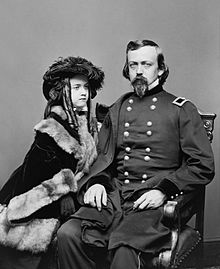
Back ستون باشا Arabic Charles Pomeroy Stone Finnish Charles Pomeroy Stone French Charles P. Stone Hungarian チャールズ・ストーン Japanese Стоун, Чарльз Помрой Russian
Charles Pomeroy Stone | |
|---|---|
 Charles Pomeroy Stone and his daughter Esther, who was known as Hettie, photographed together in the spring of 1863; Stone's USMA class ring can be seen on the little finger of his right hand. | |
| Born | September 30, 1824 Greenfield, Massachusetts, U.S. |
| Died | January 24, 1887 (aged 62) New York City, New York, U.S. |
| Place of burial | West Point Cemetery, New York, U.S. |
| Allegiance | |
| Service/ | United States Army Egyptian Army |
| Years of service | 1845–1856, 1861–1864 (United States) 1870–83 (Egypt) |
| Rank | Fariq (Egypt) |
| Commands held | Benicia Arsenal Defenses of Washington, D.C. 14th Infantry Regiment Corps of Observation Chief of Staff, Army of the Gulf Chief of Staff, Egyptian Army |
| Battles/wars | Mexican–American War American Civil War |
| Signature | |
Charles Pomeroy Stone (September 30, 1824 – January 24, 1887) was a career United States Army officer, civil engineer, and surveyor. He fought with distinction in the Mexican–American War, earning two brevet promotions for his performance in the conflict. After resigning and surveying for the Mexican Government, he returned to the U.S. Army to fight in the American Civil War.
Stone was reportedly the first volunteer to enter the Union Army, and during the war he served as a general officer, noted for his involvement at the Battle of Ball's Bluff in October 1861. Held responsible for the Union defeat, Stone was arrested and imprisoned for almost six months, mostly for political reasons. He never received a trial, and after his release he would not hold a significant command during the war again. Stone later served again with distinction as a general in the Egyptian Army, and is also noted for his role in constructing the base of the Statue of Liberty.